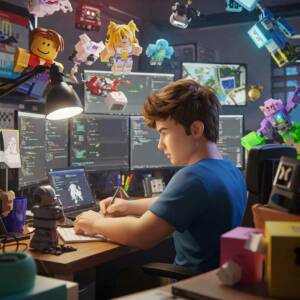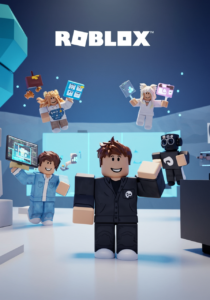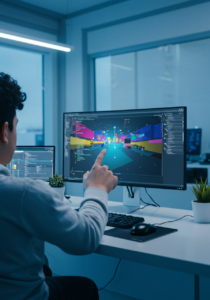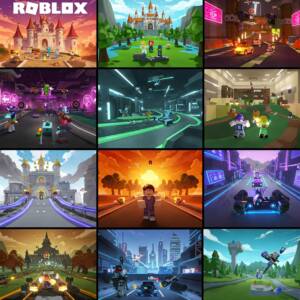Case Study: How Roblox Became a Global Gaming Phenomenon & What It Means for Omniverse City
A Look Back to Move Forward
In the ever-evolving world of gaming, few platforms have reshaped the landscape quite like Roblox. What began in 2006 as a niche sandbox experience quickly exploded into a vibrant, player-driven universe. Today, with over 200 million active users each month and a thriving in-game economy, Roblox has grown into far more than a game—it’s a movement.
However, even success stories offer important lessons. And for emerging platforms like Omniverse City, understanding Roblox’s journey isn’t just valuable—it’s foundational. 

User-Generated Content: Where Creativity Became Currency
One of Roblox’s greatest innovations was empowering users to become creators. Through Roblox Studio, anyone—regardless of coding background—could build games, worlds, and experiences. This wasn’t just a feature. It was the foundation for an entirely new ecosystem.
Players weren’t limited to consumption. Instead, they shaped the platform, influenced trends, and even built full-time careers by monetizing their creations.

Omniverse City is poised to take this model even further. While Roblox simplified game development, Omniverse City plans to integrate AI-assisted tools that remove even more technical barriers. As a result, creativity becomes more accessible, and creators gain fuller control over their ideas, execution, and revenue.
Virtual Economies: When Games Became Businesses
Roblox’s in-game currency, Robux, introduced a powerful monetization model. By purchasing Robux, players could access exclusive content, premium game modes, and digital goods. Meanwhile, developers earned a share of this revenue—fueling the rise of an entirely new economic layer inside the game.
That said, the system isn’t perfect. Revenue splits heavily favor the platform, leaving many developers frustrated.
Omniverse City sees this as an opportunity to innovate. By offering creator-driven economies, flexible monetization models, and even NFT-backed assets for transparent trade, the platform aims to shift the balance back in favor of creators. Moreover, built-in AI pricing tools will help developers optimize their revenue in real time, based on player behavior and demand. 

Cross-Platform Access: The Power of Playing Anywhere
Another key to Roblox’s meteoric rise has been its accessibility. Available across PC, mobile, Xbox, and VR, it invites players to jump in—anytime, anywhere. That kind of flexibility fosters not just convenience, but community.
Omniverse City intends to take this accessibility one step further. By building for true cross-platform interoperability, it aims to let players move seamlessly between devices and even metaverse ecosystems. Imagine creating a world in Omniverse City and sharing it across Fortnite, Fab, and beyond—all without starting from scratch.
Community: More Than Gameplay, It’s Belonging
While features matter, community is what keeps players coming back. Roblox has long been a hub for social connection—where players not only game, but gather. Through live events, creator collaborations, and shared spaces, it built something many platforms strive for: emotional engagement. 

That said, there’s still room to grow. Omniverse City recognizes that the future of gaming lies in gamified social interaction, live immersive events, and creator-player relationships that feel real. With built-in forums, live streaming, and Discord-style communities, it wants every player to feel seen, heard, and involved.
Learning from Gaps: Where Omniverse City Can Lead
While Roblox’s accomplishments are undeniable, its challenges present real opportunities for platforms like Omniverse City to evolve the model:
-
Revenue Sharing: Unlike Roblox, which keeps a sizable chunk of developer earnings, Omniverse City plans to offer more transparent and equitable revenue splits.
-
Game Discovery: Smaller creators often struggle for visibility in Roblox’s crowded marketplace. Omniverse City will implement AI-powered discovery that tailors recommendations to each player’s interests, giving fresh ideas a chance to shine.
-
AI Integration: Roblox Studio still requires some coding fluency. Omniverse City will reduce that friction by offering intuitive AI-assisted development tools, so creators can build complex environments and systems with minimal technical effort.

Final Takeaways: A Future Built By Creators, For Creators
There’s no denying the impact Roblox has had. But now, a new wave of creator-first platforms is rising—and Omniverse City is leading the charge.
By combining accessible AI development, player-controlled economies, and deep social engagement, it offers an ecosystem that feels less like a product and more like a place. A place where creators don’t just contribute—they thrive.
So what does this mean for you?
Whether you’re a seasoned developer, a dreamer with a story to tell, or a gamer looking for something new, Omniverse City was built with you in mind. The tools are smarter. The worlds are richer. And the possibilities? They’re just getting started.
🌐 Ready to build what’s next? Join the creator movement in Omniverse City →theomniverse.city
